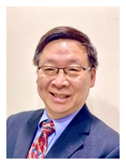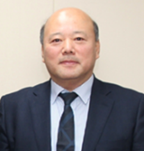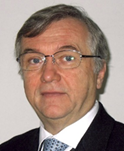| PL-1 | |
| Jyh-Wei Lee (Ming Chi University of Technology, Taiwan) | |

|
|
| Jyh-Wei
Lee was born in 1960 in Taiwan. He is a Distinguished Professor at the
Department of Materials Engineering at the Ming Chi University of Technology
(MCUT), Taiwan, and a Joint Appointment Professor, at the Department of
Mechanical Engineering at Chang Gung University, Taiwan. He has been the
Director of the Center for Plasma and Thin Film Technologies (CPTFT) since
2021 and the Director of the International Ph.D. Program in Plasma and Thin
Film Technology, MCUT, since 2023. Prof. Lee is the Chair of the AVS-Taiwan
Chapter and a member of the Editorial Board of Surface & Coatings
Technology, Applied Surface Science Advances, and China Surface Engineering.
He is the AVS ASED Program Committee member. Prof. Lee is the Program Chair
of ICMCTF2023 and General Chair of ICMCTF2024. He also serves as an
International Program Committee Member, Symposium Chair, and Session Chair of
several International Conferences, such as ICMCTF2015-2019, AEPSE2017-2023,
ISSP2019, TACT2015-2023, PSE2022, etc. He was the 10th President of the
Taiwan Association for Coating and Thin Film Technology (TACT), Taiwan from
2018 to 2019. Prof. Lee was the Dean of the College of Engineering, Tungnan
University (TNU), Taiwan, from 2007 to 2010, and Director of the Research
Center for Micro/Nanotechnologies, TNU, from 2005 to 2010. His research focuses on developing plasma-based thin film technologies to enhance the properties and performance of functional thin films and coatings used for cutting tools, molding dies, surgical instruments, optical, antibacterial, and pollution treatments. He also investigates the nanocomposite and nanolaminated nitride, carbonitride and boronitride hard coatings for tribological applications, corrosion, and oxidation protection in related industries. Recently, he has worked on the research and development of high entropy alloy thin films and thin film metallic glass materials, which can be applied in the corrosion resistance, high-temperature, and biomedical fields. Prof. Lee is skilled in high power impulse magnetron sputtering (HIPIMS), pulsed DC magnetron sputtering, cathodic arc evaporation deposition and plasma electrolytic oxidation techniques, plasma diagnosis and feedback control, nanoindentation, AFM and related nanomechanical testing methods. Prof. Lee has some research on cold atmospheric plasma applications in medicine and health care. He also studied the chromizing and aluminizing processes for the Fe, Ni, and Co-based alloys to prolong their surface life at high temperatures in the past twenty years. Prof. Lee is the PI and Co-PI of more than 30 projects from the Taiwan government and industries, with a total budget of around 7.0 million US$ in the past three years. He holds 13 patents and publishes over 195 SCI journal papers and over 30 keynote/invited lectures in the field of PVD and related surface engineering technologies. The H-index of his published paper is 41. He is listed in the World's Top 2% Scientists published by Stanford University in 2020 and 2021. |
|
| PL-2 | |
| Eun Ha Choi (Kwangwoon University, Republic of Korea) | |

|
|
| Eun Ha Choi is one of the pioneers of pulse power plasmas and charged particles, as well as plasma bioscience & medicine. Currently he is working as Director of Plasma Bioscience Research Center (PBRC)/Applied Plasma Medicine Center (APMC), at Kwangwoon University, Seoul, Korea. He has also worked as professor and senior researcher positions at Texas Tech University (2001-2003) and Hampton University/NASA (1989-1990) and Naval Surface Warfare Center (NSWC) at MD, USA (1987-1989). He develops several novel plasma sources and approaches for material processing, biomedicine, defense application, environmental control, agriculture, and food processing. His leadership is focused on the Plasma Medicine and High Power Microwave Generation, which is a revolutionary breakthrough area of plasma/microwave interaction with biological tissues/cells for wound and cancer treatment, immuno-modulation, sterilization, blood coagulation, along with inactivation of COVID19. With 35 years of experience, he has published extensively more than 500 publications and been working as regular chair of many international conferences such as ISPB, ICPM, IVC, and KVS conferences. Among his awards are the “Plasma Medicine Award” from the International Society for Plasma Medicine and “Plasma Science and Technology Award” from the Korean Vacuum Society, which are based on the total life time achievement in 2016. He has also been included as the world's top 2% in the dataset published by Elsevier and Stanford university in 2020. | |
| PL-3 | |
| Jenq-Gong Duh (National Tsing-Hua University, Taiwan) | |
| Exploration of Atmospheric Pressure Plasma Technique in the Surface Modification on Anode Material for High High–rate Lithium Lithium–ion Battery and Rapid Organic Fertilizer Manufacturing for S ustainable Farming | |

|
|
| JENQ-GONG DUH received B.S. in Nuclear Engineering from National Tsing Hua University, Taiwan in 1974, and Ph.D in Material Engineering from Purdue University, U.S.A. in 1983. He has joined the Department of Material Science and Engineering, NTHU since 1983, and promoted to distinguished professor (2006.7—2012.4) and then Chair professor (2012.4-2022.1) and now is the Emeritus Professor in NTHU and Chair professor in Material Analysis in National Chung Hsing University. His research fields involve multifunctional coating and surface modification, fabrication of cathode and anode material for Li-battery, solder joint reliability in microelectronic package, as well as the characterization of material by electron microscopy. His current interest is focused on the employment of plasma technology in the exploration of multi-functional coating and advanced energy material development. Over the past four decades, he has published over 484 SCI papers in the international journals, given more than 456 oral presentations and posters in the international conference. In addition, 25 patents are granted. He received Merit MOST Research Fellow Award. He has also received the outstanding research award for three times from National Science Council and Ministry of Science and Technology, Taiwan, as well as the outstanding teaching award twice from NTHU. He is also the recipient of numerous social service awards from Rotary International. He was also awarded the outstanding Achievement in Guidance and Counseling from Ministry of Education. He was the coordinator for Material Engineering Program, National Science Council (2011.1 - 2013.12) and acted as the President of Taiwanese Association for Coating and Thin film Technology (2014.1 - 2015.12). Currently he is the co-editor-in-chief for Elsevier International Journal “Materials Chemistry and Physics”. | |
| PL-4 | |
| Heeyeop Chae (Sungkyunkwan University, Republic of Korea) | |
| Plasma-Enhanced Atomic Layer Etching for Metals and Dielectric Materials | |

|
|
| Heeyeop CHAE received his B.S. and M.S. in chemical engineering from Seoul National University and his Ph.D. in chemical engineering from Massachusetts Institute of Technology (2000). After his Ph.D. he joined Applied Materials, a semiconductor equipment company, in California, USA as a senior process engineer. He has been working as a professor in the School of Chemical Engineering at Sungkyunkwan University (SKKU) since 2004. He is a vice president of Korean Vacuum Society. His research interests include i) plasma enhanced atomic layer etching and deposition, ii) low global warming etching gas development, iii) plasma monitoring and machine learning and iv) light emitting quantum dot materials and devices. | |
| PL-5 | |
| Cristian Petrica Lungu (National Institute for Laser, Plasma and Radiation Physics, Romania) | |
| Beryllium Dust Preparation to Mimic Particle Formation in Fusion Devices | |

|
|
| Cristian Petrica LUNGU is senior researcher at the National Institute for Laser, Plasma and Radiation Physics in Magurele-Bucharest, Romania. He is co-founder of the Plasma Processes in Plasma and Applications Group, a research team involved in design, execution and application of a new type of plasma reactor for thin films depositions based on the original method named thermionic vacuum arc (TVA), as well as other plasma based deposition methods driven by HiPIMS, DC, RF and Magnetron discharges). He was involved, together with the group members in research concerning the development of the Joint European Torus in UK and the ITER fusion reactor under construction in Cadarache, France. As scientific researcher his work was focused on hard and tribological films fabrication at Nagoya University, Sapporo University, Ube (JUTEMI) and Tokyo University during 1996-2003 in Japan, as well as in France, Italy and Germany for short term research stays. Currently, his research activity is within the frame of a project financed by EUROfusion consortium to study the plasma facing components, especially those containing beryllium. He is leading the Beryllium handling facility in Magurele-Bucharest. | |
| PL-6 | |
| Juergen F. Kolb (Leibniz Institute for Plasma Science and Technology, Germany) | |
| Plasma Treatment of Water for Agricultural Production | |

|
|
| Juergen F. Kolb received his doctorate in physics from the University of Erlangen-Nuremberg in 1999. Till 2011 he was with Old Dominion University in Norfolk, Virginia, USA where he left as associate professor for a joint appointment of the University of Rostock and the Leibniz Institute for Plasma Science and Technology (INP) as Professor for Applied Physics. At the INP he is head of the Research Program on Agriculture, Bioeconomy and Environment. His research is focused on the fundamental understanding and applications of non-thermal plasmas and pulsed electric fields for the degradation of pollutants in water, the treatment and refinement of biomass, and the stimulation of plant growth. | |
| PL-7 | |
| Masahiro Horibe (National Institute of Advanced Industrial Science and Technology, Japan) | |
| Near-future industrial innovation, Digital transformation (DX) to Quantum transformation (QX) | |
| PL-8 | |
| D. Reiter (Heinrich-Heine-Universität Düsseldorf, Germany) | |
| Divertor detachment: Fusion plasma physics meets plasma chemistry | |

|
|
| Detlev
Reiter was born in 1953 in Germany. He received the Doctor of Science degree
from Duesseldorf University in 1984. Since 1997, he is a Professor of
Institute for Laser and Plasma Physics at Heinrich Heine University (HHU)
Duesseldorf. He is interested in computational plasma boundary physics in
magnetically confined fusion devices, such as atomic and molecular gas
transport, the related collisional processes, and plasma-material
interactions. From 2007-2013 he was also Director at the Institute for Energy
and Climate research (IEK) 4, plasma physics, of Research Centre Juelich,
Germany Since 2019 he is a member of the ITER scientist fellow network (ISFN). |